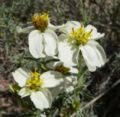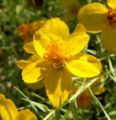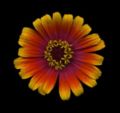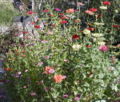Zinnia
Zinnia {{{latin_name}}}
|
Zinnia
| ||||||||||||||||||||||||||||||||||||||||
|---|---|---|---|---|---|---|---|---|---|---|---|---|---|---|---|---|---|---|---|---|---|---|---|---|---|---|---|---|---|---|---|---|---|---|---|---|---|---|---|---|---|
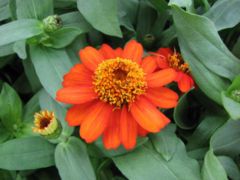
|
|
| |||||||||||||||||||||||||||||||||||||||
| |||||||||||||||||||||||||||||||||||||||||
Related to the daisy (Asteraceae), Zinnia is a genus of annuals, perennials, and small shrubs. Soft leaves are light green. Leaves vary by species from linear to a broad spatula shape. Flowers of wild species usually are like daisies, while new varieties are primarily doubles with mostly hidden or missing disc florets. Common colors found are yellow, pink, orange, and red to mahogany, but there are many more colors.
Cultivation
| Zinnia calendar? | ||
|---|---|---|
| January: | ||
| February: | ||
| March: | ||
| April: | ||
| May: | ||
| June: | ||
| July: | ||
| August: | ||
| September: | ||
| October: | ||
| November: | ||
| December: | ||
| Notes: | ||
Those commonly grown in the garden are usually frost-tender annuals which should be planted in sun, away from drafts. Keep soil moist, making sure it is well drained. They can tolerate dry periods. Extending the flowering can be done by deadheading often. Often will reseed.
Propagation
Seed.
Pests and diseases
Powdery mildew, caterpillars (which some gardeners plant Zinnias to attract).
Species
About 20 species. Zinnia elegans, (syn. Z. violacea) is the most common.
Species include:
- Zinnia acerosa (syn. Z. pumila, Diplothrix acerosa) - desert zinnia
- Zinnia angustifolia - narrowleaf zinnia
- Zinnia anomala - shortray zinnia
- Zinnia bicolor
- Zinnia elegans (syn. Z. violacea)
- Zinnia grandiflora - Rocky Mountain zinnia
- Zinnia haageana
- Zinnia linearis
- Zinnia maritima - Palmer's Zinnia
- Zinnia maritima var. maritima
- Zinnia maritima var. palmeri - Palmer's zinnia
- Zinnia peruviana - Peruvian zinnia
Gallery
-
Zinnia acerosa
-
Zinnia grandiflora
-
Zinnia peruviana
-
Zinnia bicolor
-
Single zinnia flower
-
A bed of zinnias
References
- Flora: The Gardener's Bible, by Sean Hogan. Global Book Publishing, 2003. ISBN 0881925381
